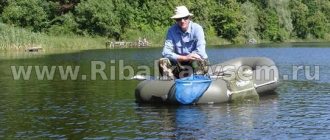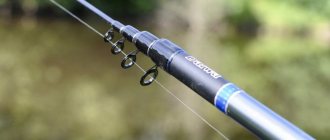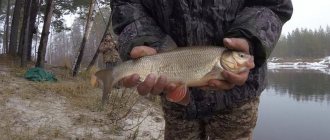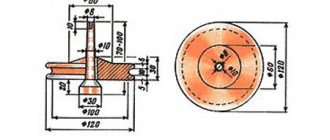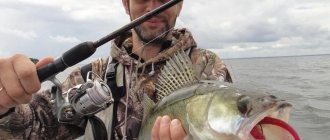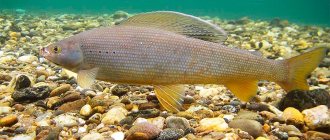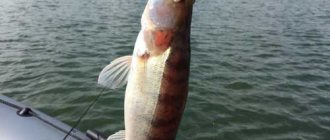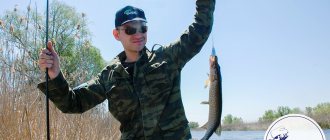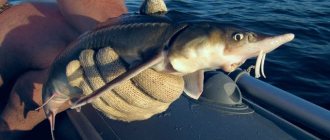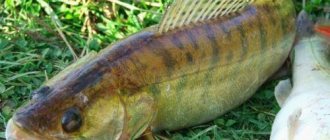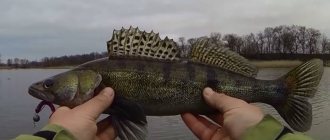Tackle for line fishing
Wire fishing Tackle for wire fishing is not much different from a regular float rod, but the technique of fishing with it is completely different.
Fishing requires a lot of activity from the angler; the fishing rod is constantly in the hands, and all attention is focused on the float. Moreover, you have to move the tackle with bait to a new place much more often. Wire fishing is highly sportive and requires certain skills from the angler. Consequently, the fishing rod must be properly adjusted with the expectation of greater sensitivity, at which you can easily notice the fish touching the bait and hook it in time. Therefore, all parts of such a fishing rod should be as comfortable and light as possible. The equipment must correspond to the fish that is supposed to be caught in a given body of water. It is better to choose a fishing rod that is as light as possible but durable. Of all the options, you should probably choose a carbon fiber telescope. With a relatively low weight, such a fishing rod has great strength, and when fishing for large fish, it is flexible enough to absorb the jerks of a resisting fish. This will allow you to use a thinner, and therefore less noticeable fishing line in the water.
The length of the fishing rod does not play a special role, the only important thing is that it is convenient to handle. A 5-6 meter rod will be quite enough. But in terms of its characteristics, a medium action rod will be the best. Since a soft one will not allow you to make an accurate hook at the right moment, and an excessively hard one excludes the possibility of using thin fishing lines.
Particular attention should be paid to the passage rings. It depends on them how long the fishing line will last, because it has to constantly rub against the rings when casting and, especially when retrieving. Perhaps the best are ceramic ones with a steel frame or composite ones made of highly abrasion-resistant materials. But there are also good ones made of steel, stainless steel or with an anti-corrosion coating. No matter what rings the rod has, upon external inspection there should not be the slightest notch on them, which very quickly frays the fishing line and renders it unusable. Increased demands are placed on the “tulip”, since it takes on the greatest load when casting bait and retrieving prey. The most resistant to abrasion are quartzite, agate and ceramic porcelain rings. And if, after several intense fishing trips, grooves left by the fishing line are visible on the “tulip”, then it must be replaced without delay.
Getting into the Wiring Now about the coil. Here, in principle, it’s all a matter of taste or even habit. But we must proceed from the fact that when fishing, you usually have to throw the bait upstream, and in some cases quite far. In addition, the nozzle is relatively light and small. Therefore, the reel must provide accurate and long-distance casting of such a bait. A small, inertia-free one is optimally suited for these purposes. One of its advantages is that it virtually eliminates tangling of the line when using light weights. Of no small importance when choosing a “meat grinder” is its gear ratio, that is, the number of rotor revolutions per revolution of the handle. For wire fishing, high-speed reels with a gear ratio of 6-7 are more suitable. Then it will be easier to eliminate sagging line between the rod and the float. But still, no matter which reel you prefer, pay special attention to how its use will affect the structure of the tackle as a whole. The reel should fit harmoniously with the rod.
The float used for retrieving is durable, non-wet, sufficiently load-bearing, sensitive to bites, such that it does not scare away the fish, but at the same time is clearly visible. It is generally accepted that an elongated, cigar-shaped cable is more suitable for wiring. This float has less resistance when hooking and, when properly loaded, is very stable even in windy weather.
When fishing in the wiring, the correct loading of the float is not the least important. In the best case, 2-4 pellets dispersed throughout the forest are used for this. The first, the smallest, is 5-6cm from the hook, the next is 10-15cm higher, and so on with increasing distance between the pellets. You can use two weights. One is a pellet, and above it is a spindle or stalk. Then there will be fewer splashes when casting, and when biting, such tackle will provide less resistance, which means the fish will take the bait more boldly.
The hooks you choose must be sharp from No. 3 to No. 8, depending on the bait and the intended fish. When fishing with animal baits - worms, maggots, bloodworms - the hook should have a long shank. And if you are fishing with a large bait, for example, a crawler, a dragonfly, then it is desirable that there are also barbs on the fore-end, then the worm will not slide off, and the fish will not be able to pull it off. Often when fishing, vegetable baits such as steamed peas, barley, corn or bread pellets are used. For these baits, it is better to take hooks with a short shank, so that it is easier for the fish to swallow it and, as a result, there will be fewer empty bites and escapes. There are hooks with a sting slightly bent inward towards the forearm - “Japanese”. When fishing with a retrieve in the current, they hit less obstacles. A correctly tied hook, floating downwards, faces the sting towards the fish swimming towards it and at the same time upwards. When biting and hooking, this hook is in the best position in the fish's mouth.
Fishing places
One thing is a well-chosen fishing spot. The diversity of the bottom topography has a positive factor for the accumulation of fish. Bottom research also plays an important role in determining a suitable area for fishing. For this purpose, you can use a pole or a long stick for an approximate depth. As for the current, it should not be with whirlpools. A smooth current will be the key to good viewing of the float and successful hooking. Writhing, grass and stones should also not litter the bottom of the chosen place.
When establishing a deep descent, it is important to note that specimens such as bream, podust, ide and minnows prefer to take bait that practically floats along the bottom. But a higher position of the nozzle is more to the liking of dace, roach, perch and chub
If fishing is planned for several days, then you should carefully check the depth to which the tackle is lowered. Experienced fishermen say that sometimes their surprise was great when, on the next day of fishing, a baited spot, which the day before brought an excellent catch, turned out to be occupied by small fish. The explanation given for this was that after rain fell at the highest point, the water level rose and the biting pattern changed.
As for the hook, it is very important that it is very sharp. When fishing occurs in the manner described above, then, as a rule, the fish holds the bait in its mouth just a little
If she feels that the hook has pricked her, then the bait floating past her is immediately thrown out. It is for this reason that a sharp hook and good response from the angler are so important when fishing with a wire.
Fishing technique
Wiring fishing has its own secrets and subtleties. They are caught by wire during the entire period of open water. In spring and autumn you can fish throughout the whole day, but in summer it’s better at dawn. As autumn approaches, deeper locations should be chosen. Fishing requires special skills in managing gear and the ability to choose the right place for fishing.
The attachments for fishing in the wire are different and depend on the intended fish. You can use worms, maggots, bloodworms attached with a brush, small caterpillars, dragonfly larvae and chafers, as well as steamed peas, rolled oats, pearl barley, semolina dough and bread crumb.
Fishing in line from a boat Having chosen a convenient place, first of all you need to make sure that the bottom in the path of the bait’s passage is not stuck. It should be smooth and clean and preferably constant in depth. The depth of the reservoir at the fishing site is measured with a depth gauge or test swims of the bait, making an approximate release from the float to the hook. Then the float is secured to the line in such a way that when reeling, the nozzle barely touches the bottom.
When the place is chosen, you need to feed the fish. There are a great variety of bait recipes and each fisherman has his own, but it should be taken into account that when fishing in still water, the bait should be more crumbly than when fishing in the current. In addition, during the current, the bait is lowered to the bottom slightly above the fishing spot, in such a way that the food particles are washed away by the water and attract fish. Even in those reservoirs where there are fish, it is much better to use bait, since the fish gets used to the food rushing along the current and weakens its suspicion.
After the place has been baited, you can prepare the tackle and start fishing. Usually, fish do not approach bait immediately, but after some time. For now, you can make a few test runs and secure the float to a verified location on the forest.
The cast is made upstream to the place where the bait was made so that the bait floats in a stream that washes away the food. When, after casting, the float takes its assigned vertical position, you should move the rod upward to eliminate the sagging line. This is a very important condition and it is necessary to ensure that it is fulfilled throughout the passage of the bait. Such management of the float on a stretched line is necessary for timely hooking at the slightest suspicion of a bite. Lightly holding the float, allow it to float the entire length of the line. If there was no bite during the swim, you should still make a short hook at the final stage when the float is pulled into the water. The fish often grabs precisely at this last moment when the bait is lifted by the current from the bottom.
If the bite does not occur, then choose an excessive length of fishing line and remove the nozzle from the water. Then they repeat everything again - casting again, waiting for a bite and, if lucky, hooking and landing the fish. This fishing process may seem tedious, but believe me, it is worth it. Any fish lives by instincts and it also feeds instinctively; even herbivorous fish have a grasping reflex. That is why even when a fish is well-fed, it cannot resist the desire to grab the food floating by.
When fishing from a bridge or from a boat, fishing is a little different. Having cast the bait, let it float with the flow, releasing the line from the reel. But do not forget that the line must be slightly taut at all times, and the angler himself must be extremely concentrated. If there are no bites, they fish out the entire line and use a reel to pull it towards themselves. After that, remove the reel from the brake again and let the nozzle go downstream. In addition, it is much easier to get to almost any place by boat. For example, fishing by wire can be successful along the edge of near-water vegetation or in whirlpools behind piles, bridges and other structures.
Choosing a place for fishing with wiring
In order for fishing on the river to be effective, you need to choose the right place for fishing. The fish prefers to live in places with varied bottom topography. Therefore, you need to calculate the place on the river where the current will carry the bait over various holes, ravines, edges, snags, etc.
You can also successfully fish over bottom vegetation while fishing. For example, summer chub practically does not leave such places, and it is almost impossible to catch it in any other way, because all the bait will remain captive in the algae. If a place has been chosen, then it’s time to talk about fishing gear for fishing on the river.
Preparing the fishing site
The next step is to accurately measure the depths in the wiring area. I always do this without removing the leash. In order to avoid snagging and subsequent fuss with the almost inevitable breakage of the leash when setting the wiring depth, I select the densest grain of wheat or pearl barley and place it on the hook, covering the tip and thereby reducing the likelihood of snags to zero. With this method, you can even drag the rig openly along the bottom, looking for places for wiring by dragging along the bottom. By the way, I noticed that the higher the sun, the deeper the fish go. Therefore, for a specific place, I outline for myself several paths for the float to float at different distances from the shore, and I try on each such path with several passages. Having determined the depth, I put the rod on the stand and, pulling the line, noting to myself the position of the float (for example, 5 cm above the third guide ring). This will help set the initial depth, which can be lost during sharp hooking and casting.
Catching various fish
Using line fishing you can catch a wide variety of fish:
- To catch ide, use a float tackle. The bait is cast upstream, then it is carried along the river by lowering the fishing line. The bait can become more visible to the school if you play with the float, holding it and then releasing it. You can catch ide using fishing from the shore, standing on a scaffold, or from a boat.
- In the spring, chub are caught in the wire. Rivers flood and drive fish out of their winter shelters, and they begin to look for food.
- In summer, you can try your hand at perch fishing. It's a lot of fun, even though it's not easy to catch a perch. Fishing from a boat will be more effective. You can use a vertical spoon as a tackle. The boat should be allowed to float freely, and the bait should move at shallow depths. You also need to jerk the rod sharply.
- To catch bream, you need to choose calm rivers with a depth of no more than 3 meters. Fish of the carp family are often found in such rivers. Experienced bream hunters are advised to examine fishing spots in advance, since bream is a very shy fish. The best period for catching bream is from late May to November in the morning.
Catching chub with wobblers
The autumn chub continues to actively show itself on wobblers. In warm weather, you can continue to use crankbaits with active play. But you should choose larger sizes. If you use cranks, as in the summer, then small individuals will be caught on the hook more often. It’s better to take 40mm ones to catch larger chubs.
Autumn fishing for bass can be complicated due to incorrectly selected bait. Its color matters. To begin with, it is recommended to use rolls that have natural, natural shades. Dark colors are also suitable.
Minnow wobblers perform well with the onset of October cold weather. Even by playing on the most sluggish retrieve, there is an opportunity to stir up the big-headed fish, which no longer wants to actively move behind the cranks. Fishermen often use deep-diving wobblers.
Wiring fishing on lakes and ponds
More often they fish by wire only in places where there is a current, but this method can also be used on lakes. Only it requires good gear and... wind. It may well compensate for the lack of current in the lake. All components of your fishing rod should be strong, light and adjusted. The design of the fishing rod determines the distance to which the bait is cast and the speed of fishing for the caught fish.
A good fishing rod is the key to your success. It is very important to choose a sensitive float. Its sensitivity depends on the shape, size, color and method of attachment. To catch fish while fishing, it is better to use a sliding float, the base of which is made of a ballpoint pen. A lead weight is attached to the bottom of such a float. If you take these details into account, fishing on the lake will be no worse than river fishing.
Wiring for the outlet leash
When fishing with a retractable leash, the following are most often used:
- classic stepped wiring;
- wiring for demolition.
In addition, when fishing with this rig, you can play with the bait at one point for a long time: after the weight drops to the bottom, the angler performs various swings and pulls with the tip of the spinning rod, “revitalizing” the bait. The load remains motionless. This technique is well suited for spot fishing of promising areas and perfectly attracts a passive predator. Features of wiring for different types of fish
Each fish has its own preferences - both in the choice of places and times for hunting, as well as preferences for baits and methods of their animation.
However, when fishing, situations often happen when, for example, an angler who is aiming to catch a small pike in the coastal zone begins to receive one perch bite after another, or a spinner who was going to catch a perch on the edge suddenly pulls out several one after another. pike perch.
Thus, despite the fact that certain recommendations can be given for catching each specific fish, any spinning bait and wiring is quite universal and can attract any predator.
Using these basic spinning techniques, you can achieve good results in catching predators in any conditions. But we should not forget that in order to achieve a truly high level of fishing skill, constant searches and experiments are necessary - only this will allow you to comprehend all the intricacies of fishing science, get real pleasure from being on the reservoir and always end up with a good catch.
In conclusion, we present to your attention a video that clearly demonstrates the knowledge gained. Enjoy watching!
Feeding tactics
Having decided on the location, the first thing I do is add water to the bait, mix it thoroughly and leave it to swell and soak. In the meantime, I’m busy setting up a fishing area. To begin with, I will remove all stick branches and overhanging vegetation to avoid the equipment getting caught on them during casting. For the same purpose, I clear the space in front of me. I will definitely fix a couple of fishing rod stands in the ground parallel to the river - they are not directly involved in the wiring process, but they will be indispensable when tying the equipment, adjusting the depth and other issues. I place the rod on stands, and not in the grass covered with dew, so that the line does not stick to the blank. For the same purpose, I keep a piece of a clean, dry rag on hand so that from time to time I can wipe the rod blank from moisture, which is often present in the form of condensation in the early morning. Next, I unfold the chair (it is advisable to sit on the ground while fishing only if there is good insulation of the buttocks from the cold spring soil - a polyurethane foam mat will do this task perfectly), I place the landing net and fish tank within arm’s reach. I place containers with bait and leash holders with extra leash nearby so that during the fishing process I don’t have to run after them.
Next, I begin to lure fish, based on the fact that the length of the line usually does not exceed five meters with a casting length of 5-6 m from the shore, that is, the line comes almost from the point of the fishing rod.
Read! Autumn fishing with a fishing rod and jig
It’s just great if downstream there is a blockage of cramps, bushes, trees - there will be fish there one hundred percent. I immediately try to outline for myself a clear trajectory for running the float - “from now to now.” I begin to throw the bait balls a little higher from the intended casting point so that the current does not drag them lower, and there is a bare, unbaited place left on the wiring section. Gradually, at short intervals, I throw the balls, forming a kind of path to a blockage of cramps or some other bottom anomaly. In this way, it is possible to lure the fish even from a remote shelter to the fishing site. If the current is strong, then I flatten the balls of bait into sort of cakes so that they cling better to the bottom soil and do not roll over it.
I usually make about half of the initial feeding more crumbly, which helps create an abundant trail of feed. And the density of the balls, which I supplement with during the fishing process, will depend on the bite.
While the bait begins to work, collecting fish, I am adjusting the equipment. To begin with, I lower the float so that its sensitivity is not lost and is clearly visible. I try to surround even a float with a long antenna so that only its tip protrudes from the water - if the wind rises at dawn, and even blowing with the current, then my alarm will be less affected by the wind than when the antenna is long, albeit thin.
Posting a float on the river
First of all, when choosing a fishing line, the size and type of bait, the size and type of fish being caught, and the degree of its activity are taken into account. And it’s not without reason that the bait is put in first place, from which it’s worth “dancing” when choosing a specific wiring. For example, on a river, guides use two main methods of guiding bait: dragging along the bottom and guiding above the bottom. With dragging, everything is more or less clear: the bait with part of the leash should be dragged along the bottom soil, the sub-grass (or a group of pellets, or just one large olive) goes slightly ahead of the bait. Any holding of the float during dragging is usually not done; on the contrary, they try to achieve free movement of the float, giving the line even a little slack so that the float does not come off a certain baited stream.
Herringbone float wiring
Fishing above the bottom is used by fishermen more often than dragging, and there are reasons for this. Wiring above the bottom allows you to use various interesting techniques, for example: “drawing a Christmas tree.” This float wiring is performed as follows. We cast the rig, the float floats freely for some distance, then we hold it with the rod. While holding, the equipment (and along with it the hook with the nozzle) is pulled a little towards the shore. In addition, with such a hold, the bait, under the force of the current, rises above the bottom. After holding, we again send the float into free floating - the nozzle again sinks to the bottom, but now follows the stream slightly closer to the shore. Then a hold is made again and a free swim follows again - this results in an interesting maneuver, similar to the geometry of spruce branches.
This “herringbone” pattern can be made in countless variations. For example, a free swim between holds can be very short (less than half a meter), or it can be long. Holding the equipment can be for a second or for a long time, during which we achieve the raising of the hook with the nozzle into the upper layers of the water. The holding itself can be different: from a complete stop of the rig by the rod, to different speeds of braking, when the rig continues to move, but its speed is less than the speed of the current.
Drawing a “Christmas tree” is very exciting and rewarding; often this method of river guiding saves you when there is no bite on the river at all. The “herringbone” pattern is especially indispensable when you are looking for fish without bait, feeling for the stream where it will hatch. But when fishing with a herringbone pattern, you need to get the hang of it. You have to throw a series of balls with an offset to the shore - each subsequent ball (several balls) of bait is thrown downstream a little closer to the shore than the previous one. And “Christmas tree” holds work most effectively if they are done precisely above the feeding points or at least next to them.
Of course, on the river they catch both half-water and even on top, but these are not typical cases of fishing, which we are not considering today; today we are not talking about top-water fish, but about bottom-dwelling fish, that is, about the usual conditions of river fishing.
"Scratching on the bottom"
In addition to dragging and wiring above the very bottom, there is also this type of interesting wiring called “striking on the bottom.” This technique has been known to experienced floaters for a very long time and is recommended for use, especially for those who like to catch ide.
The placement of the float is as follows: the bait with a hook goes near the bottom, regularly touching it on small hills. “Chirk” can be considered an excellent, universal wiring for most baits when catching a wide variety of fish, and a wiring that works well for both sluggish and active fish. But, unfortunately, for “chirking” it is quite difficult to find places convenient for fishing, where large fish are kept. However, this method of wiring is very effective on the wavy bottom of river rapids, where in the summer there are a lot of different fish and where “chirping” is especially effective. And yet, this technique is more practiced when fishing with a fly rod without a reel, that is, when the length of the line is short and it is easy to find a suitable section of the river with a flat bottom.
When fishing with long casting and long retrieves, you can, for example, encounter the following situation: part of the retrieve, the hook with bait strikes along the bottom, then part of the retrieve drags along the bottom (the depths here decrease), and the final part of the retrieve the nozzle can already float above the bottom , where the depths increase. On the one hand, it would seem that this is a very interesting wiring, combining different styles and making it possible to quickly discover which option the fish likes today. However, I think that such mixed wiring on the river is no good, because each section requires its own float load. For example, when dragging, avoiding pulling the float under water, you have to put up with the roughness of the equipment and quite underload the float. When “chirking”, underload it a little so that the float does not get pulled in during a short-term “tealing”, which is in many ways similar to a bite and will lead to false hooks that scare away the fish. Well, when the bait floats freely above the bottom, it would be a sin not to use the ideal weight, which will clearly show all the bites. If you plan to conduct a herringbone pattern over the bottom, that is, with holds, then it is generally better to overload the float a little, so that when slowing down it gets out of the water less and more clearly indicates bites, which are frequent precisely at the moments of holding.
